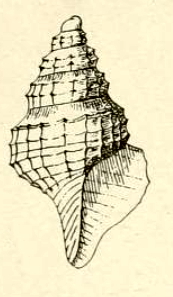Pleurotomella aculeata facts for kids
Quick facts for kids Pleurotomella aculeata |
|
|---|---|
 |
|
| Original image of a shell of Pleurotomella aculeata | |
| Scientific classification | |
| Synonyms | |
|
Pleurotomella aculeata is a type of sea snail. It's a small mollusk that lives in the ocean, belonging to a group called gastropods. This snail is part of the family called Raphitomidae.
Contents
What Does This Snail Look Like?
The shell of Pleurotomella aculeata is quite small. It's about 6 millimeters (mm) long and 3.3 mm wide. That's roughly the size of a small bead!
Shell Color and Shape
The shell is usually a light, yellowish-brown color, often called "buff." It gets lighter towards the top, which is called the apex. The shell also has a special tube at the bottom, known as the siphonal canal, which is also lighter in color.
This snail's shell has five main spirals, or whorls. Imagine a spiral staircase; each turn is a whorl. The very first part of the shell, called the protoconch, is tiny and has a cool net-like pattern. It makes up about one and a quarter of these spirals.
Cool Patterns on the Shell
The shell has unique patterns, which scientists call its sculpture. It has raised lines, like tiny ridges, running lengthwise and slightly diagonally. These are called "ribs."
These ribs are crossed by two strong spiral lines, known as "keels." Where the ribs and keels meet, they form sharp, pointy bumps. It's like a tiny, spiky texture!
The largest part of the shell, called the body whorl, has four more keels near its base. There's also a thin line, or "thread," visible between some of these keels. The body whorl usually has about twelve ribs.
Other Shell Details
The lines where the whorls join, called "sutures," are sharp on the early parts of the shell. On the later parts, they are smoothly curved inwards.
Inside the shell, the central pillar is called the columella. It goes straight down from the body whorl. The siphonal canal, the straight tube at the bottom, has about eight faint lines, or "striations."
Near the top of the shell, there's a special area called the "anal fasciole." This is a curved groove that helps the snail get rid of waste. If you look closely with a magnifying glass, you can see faint lines between the keels and the neat net pattern on the protoconch.
Where Does This Snail Live?
This marine snail is endemic to New Zealand. This means it is found naturally only in New Zealand and nowhere else in the world! You can find it living off the coast of the Northland area.

